
For some time, I’ve been looking for one “source” that curates modern takes on HR Tech, perspectives from the people who build it, and its impact on enterprise — something that’s tailor-made by professionals for decision-makers.
I never found it — so I decided to build it.
Every week, I’ll be sharing fresh insights on tech platforms, design, data, and the future of work — straight to your inbox.
My Thoughts
Let’s discuss the “live-tweeted car crash” 🔥 🚗 🔥 that took place on Sunday: the Golden Globes.
If you don’t know what I’m talking about, that’s totally understandable. Instead of broadcasting a huge event, the 79th Golden Globe Awards 🏆 was live-tweeted this weekend. And those Tweets consisted of typos, accidental hot takes, confusing jokes that didn’t land, and inappropriately-placed emojis. Entirely void of both pomp and circumstance, the night seemed to formally punctuate the award ceremony’s long fall from grace. 😬
How did this institution crash and burn so spectacularly after 80 years of credibility? In addition to accusations of bribery, the Globes has a lengthy history of criticism for the lack of diversity among nominees and winners. While it’s governing body, the Hollywood Foreign Press Association 🎬 did respond to growing outcry by nominating more People of Color in recent years, it was revealed just one week before the 2021 Golden Globes that the selection committee had no Black members.
Though the Hollywood Foreign Press Association responded to the scandal with multiple promises for reform, their efforts were hollow and fruitless. One HFPA member was exposed for criticizing the Black Lives Matter movement. ✊ Both the diversity consultant and crisis PR firm quit within months, citing the HFPA’s refusal to commit to concrete actions. The whole ordeal culminated with NBC dropping the Golden Globes until at least 2023.
And yet, instead of focusing on addressing the extreme problems within the institution, the Golden Globes chose to move forward with the 2022 ceremony via Twitter. It’s probably not a surprise to hear that it was still fraught with the issues that had reduced the once-beloved celebration of cinema to a social media sideshow grasping at relevance with bizarre, misspelled tweets. 🐦
Ultimately, what will lead to the end of the Golden Globes is the irreparable damage these failures have caused to their brand. ⚰️ Even if the HFPA were to completely overhaul its DEI initiatives, I don’t think any organization could come back from this kind of blatant disregard for social reform. You can’t put a bandaid on a broken vase and expect it to be water tight. Your only option is to not break the vase in the first place. 🏺
Market Moves
Last week, I discussed the ups and downs of several stocks including Zoom and Peloton 🚲 that have been riding the waves of pandemic-era booms and busts. But there is one industry that has been on the up and up since the beginning: talent management. According to Fortune, the global market was valued at $6.45 billion in 2020, and is expected to reach $13.21 billion in 2028. 📈 As you may have guessed, COVID has played a huge role in the development of this market, as companies scramble to rethink retention strategies amidst the Great Resignation. Given that we’re a community of HR leaders and digital transformationalists, I plan to cover this piece in greater detail in the coming months.
Tech Innovation at Work
Remember how experts were predicting that the metaverse was years away from infiltrating our day-to-day lives? Well, things seem to have moved a little faster than we were anticipating. Last week at the 2022 Consumer Electronics Show (CES), virtual experience company Touchcast unveiled the first enterprise-level metaverse, MCity. Complete with live Microsoft Teams integration, companies can build digital renderings of their campuses (or create a better version of their windowless office space). The announcement makes Touchcast the first provider of “Metaverse-as-a-Service,” a headline we all know Zuckerberg is fuming over. The venture is being powered by several big names — with Epic Games, NVIDIA, and Microsoft forming the digital building blocks and IT company Accenture identifying how to successfully introduce and migrate organizations into this unfamiliar territory. As of right now, the full MCity is still in private beta, meaning the VR door is locked for now. However, you can claim your .metaverse domain here while you wait.
Here are some of the other noteworthy drops from this year’s CES:
Panasonic and Steam’s new VR headset: MeganeX which is the lightest and most compact model to hit the market so far. A pair weighs in at just under 9oz, but still manages to pack in high-res screens with special functionality that allows nearsighted individuals to use them without their prescription.
BMW’s Color-Changing Car: The days of agonizing over which color your new car should be are gone. BMW’s new iX Flow electric crossover vehicle is powered by cutting-edge E Ink, which, until now, has only been utilized for e-readers.
Bird Buddy’s smart birdfeeder: Maybe this one is only for the ornithologists, but I think this new smart bird feeder is a long time coming. The battery-powered camera (soon to be solar-powered, according to their site) sits within the feeder, sending video footage to an app on your phone. The app will also identify bird species, unlocking facts and tips like what kind of food they prefer.
Nokia 2760: If someone from the early 2000s were to trip over their Ugg boots and stumble into a time machine en route to the 2022 CES, the last thing they’d expect people to be fawning over is a flip phone. That being said, what better way to celebrate the return of Y2k trends than with an iconic Nokia. Unlike brick phones of the past, though, this one comes equipped with modern 4G.

Fast Company released a very nicely bundled executive summary of all the reasons companies need to be embracing the latest HR tech. 🖥️ The biggest argument being to protect against — you guessed it — the Great Resignation. The piece touched on one of my most deeply-held beliefs for recreating a successful people management program: stop thinking of HR as a cost. If a company’s most valuable and vital asset is machinery, no one thinks twice about the costs of maintaining and improving it. 🛠️ How talent management has yet to universally reach that understanding is beyond me, but I don’t want to go off on a rant. Read the article here.
The Changing Workplace
2022 is the year of pay transparency. New York City 🗽rang in the new year with a bill that will require city employers to provide the minimum and maximum salary for a position in all advertisements for a “job, promotion or transfer opportunity.” Last quarter, Nevada passed legislation mandating that pay ranges be disclosed for certain positions. Washington and Connecticut are following a similar suit. Colorado is taking a tangential approach to pay transparency with a new law that requires employers take “reasonable effort” to announce or make known promotions — including salary — to all employees. 👨🏭 All in all, the new requirements have been well-received, already helping expose and combat wage disparities across gender and racial divides. However, there will always be naysayers. 👎 In this case, the naysayers are painting a picture that wage transparency laws are resulting in discriminatory hiring and poaching. In my totally honest opinion: ignore those arguments. Equal pay for equal work is something every employee in any company is entitled to, and the benefits for your organization are abundant, too.
Google is the latest in a series of mega-corps to come under fire for union-busting. Court documents released this week show that, since 2018, Google has been engaging in anti-union behavior 👿 as part of an overarching campaign called Project Vivian. As part of the company’s strategy to hide evidence of wrongdoing, Google is reported to have pressured employees to label documents and communication as “attorney-client privileged,” 👩💼 💼 which was first reported by the New York Times in 2020. This week, a judge has ruled that approximately 200 documents had been improperly characterized by Google, with those and an additional 1,000 so-called “privileged” documents to an NLRB-appointed judge for review. What those documents contain and how they’ll shape the future of one of the largest companies in the country is one thing I’ll be watching very, very closely in the next few weeks. 🙇 👨💻
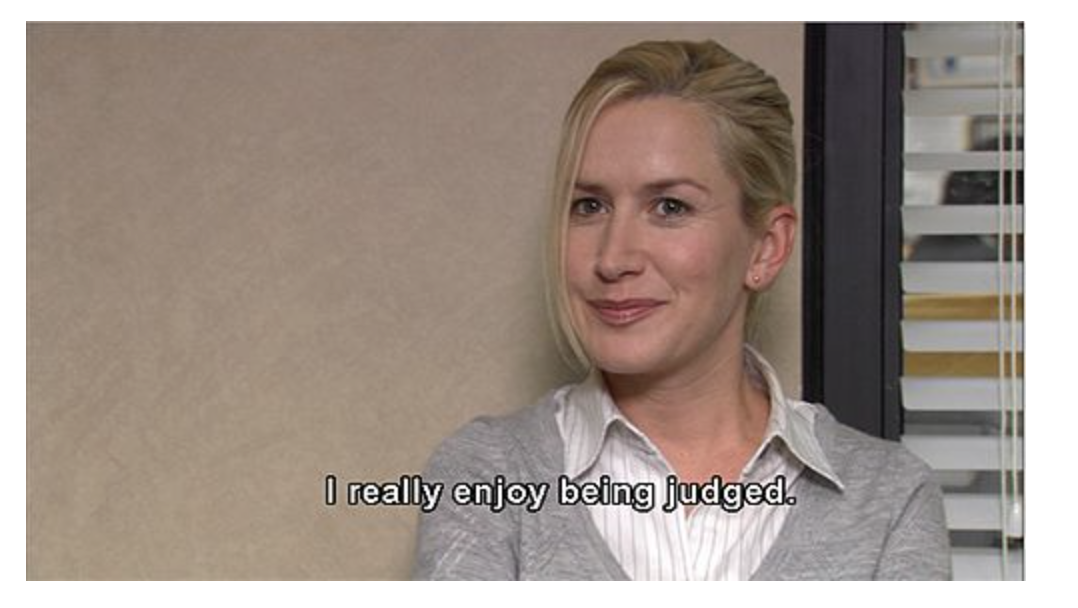
Outside of The Office character, Angela Martin, I have never heard of an employee — real or fictional — that enjoys formal performance reviews. 😬 👎 In fact, most millennial workers are terrified of them. And yet, these generations of workers crave more feedback and open communication with their managers than any other. Is this a double-edged sword? Absolutely not. 😀 Research has shown that ongoing, open dialogue is one way to keep millennial employees not just engaged, but thriving in their roles.
This understanding paves way for a valuable tool and next big trend for retaining employees amidst the Great Resignation: the stay interview. ✍️ Yes, they’ve been around for a long time, but it’s only in the pandemic era that they’ve surfaced as a mainstream element of people management. If you’ve yet to come across the topic in a frantic web search of how do I keep my employees from quitting?, 😰 a stay interview is fairly self-explanatory. Managers meet with members of their team to discuss why they’ve chosen to stay with the company in order to 1. understand what the company’s competitive advantages are when it comes to attracting talent and 2. ensure that employees are happy and, if not, find solutions to prevent them from looking for a new job. If you do them right, stay interviews can help ensure that the only emails you get about exit interviews are from me. Here’s some inspiration from SHRM and Protocol to get you started.
All About Data
Ethics are a cornerstone of positive workplace culture. The understanding of workplace ethics has expanded beyond mere legal compliance to include social justice and activism, transparency, DEI, and more.
Top HR leaders around the world are resolving to make workplace culture and employee wellbeing priorities for 2022. If you’re planning to do the same, a new report by ethics and compliance training company LRN makes it clear that evaluating your cultural ethics is a good place to start, since how employees feel about a company’s ethics has a very real impact on both employee conduct and overall business performance.
The study surveyed 8,000 employees from around the world across 17 industries and included representation from front-line workers to C-Suite execs. Here are some of the highlights:
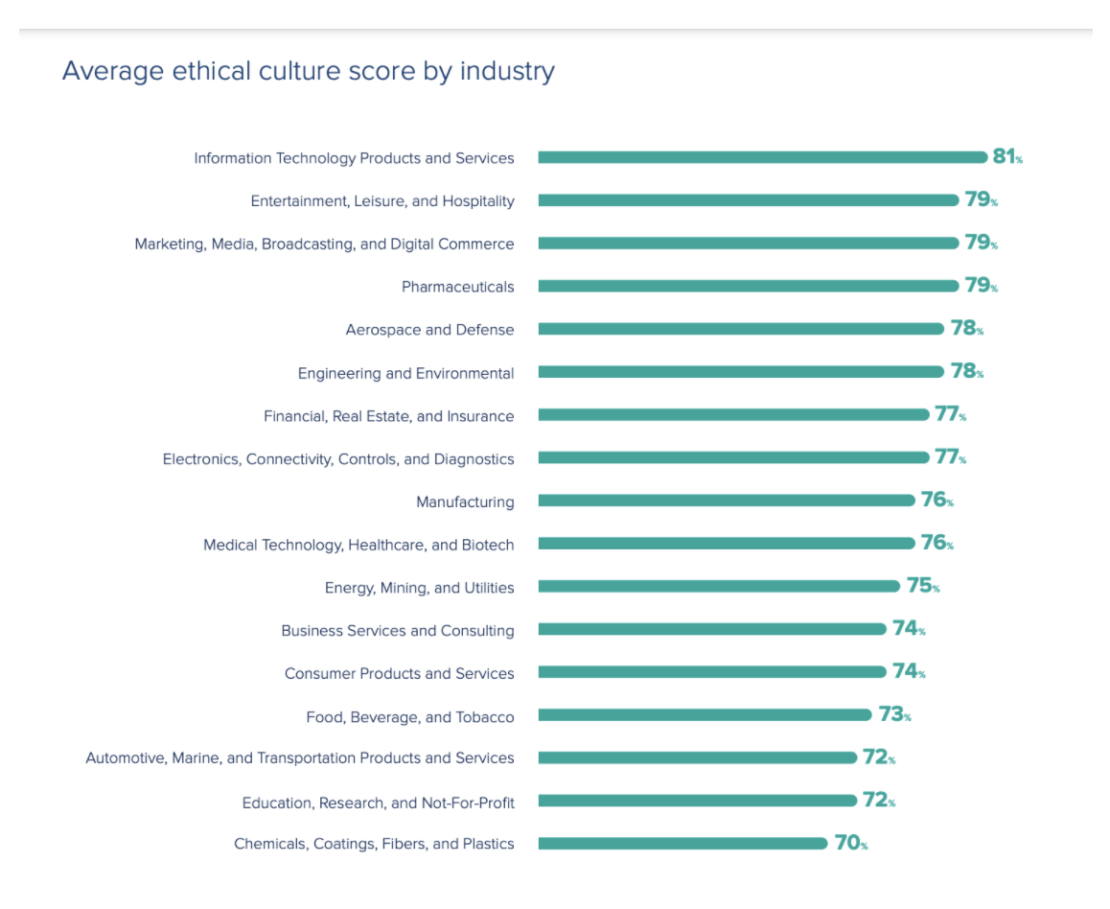
Employee opinions of their organization’s cultural ethics varies widely based on industry, with IT products and services capping out the top at 81% based on LRN’s ethical culture score. (This ethical culture score aggregates data across categories including transparency, leadership modeling, trust, and organizational justice).
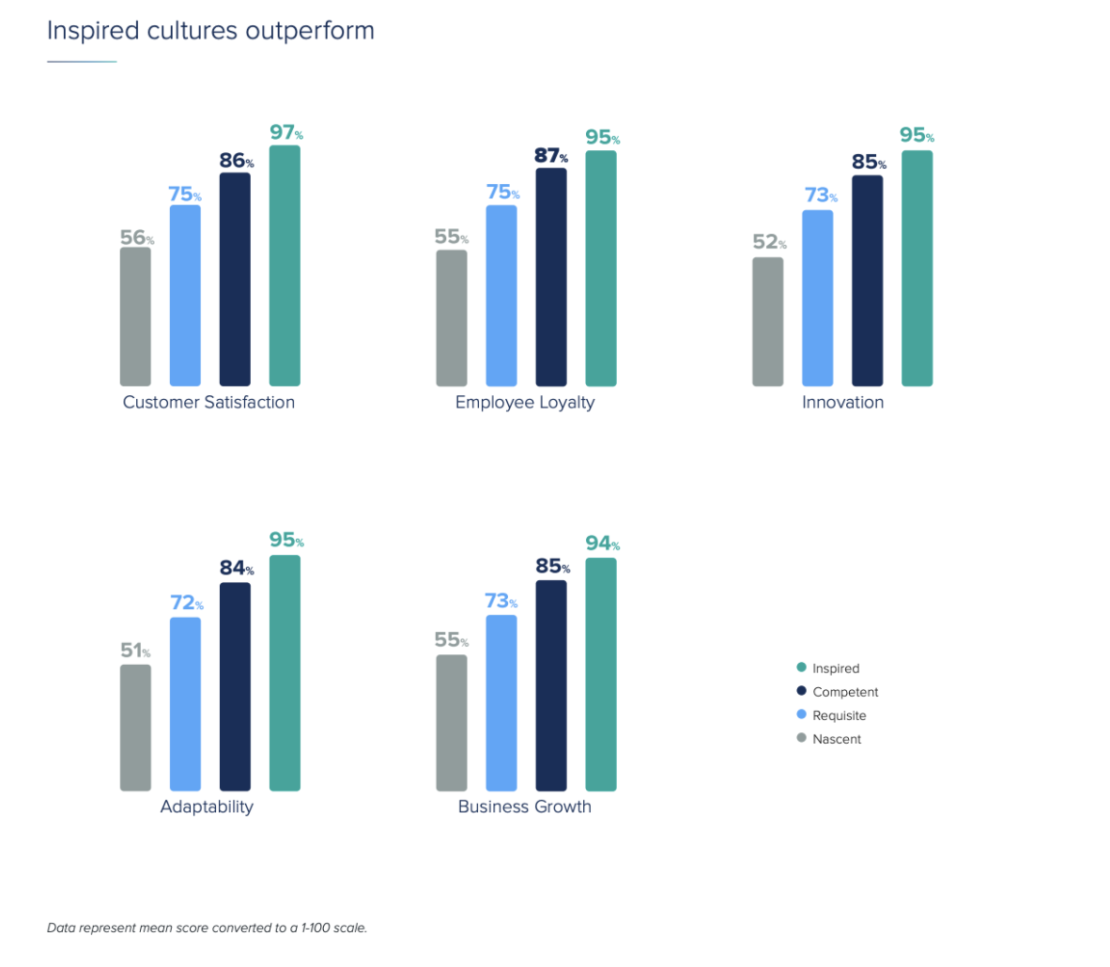
For the purpose of this report, LRN divided ethical culture scores into statistical quartiles labeled as (from lowest to highest scores): Nascent, Competent, Requisite, and Inspired. In the graph above, Inspired companies were shown to outperform Nascent companies by upwards of 40% in an analysis of traditional reporting metrics and KPIs.
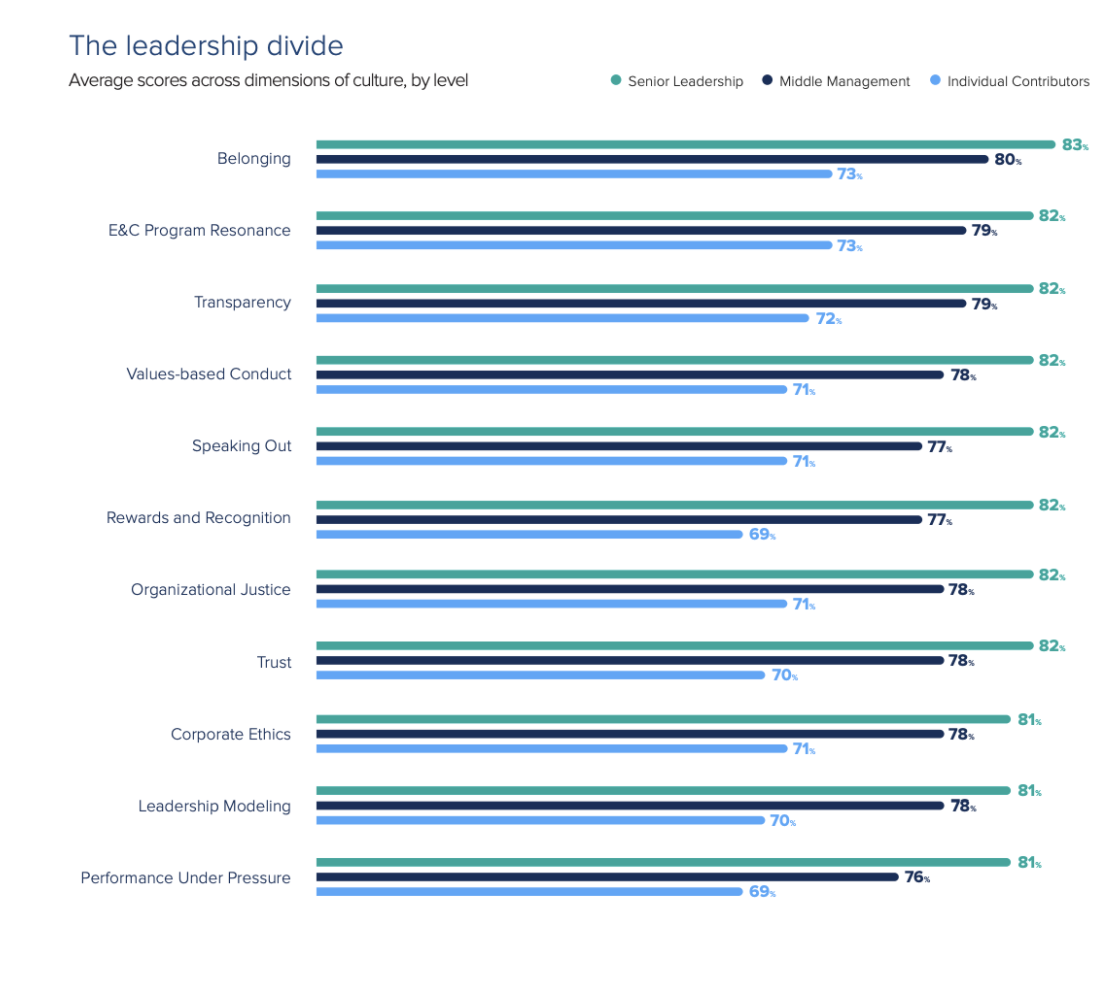
Across all categories that comprise the ethical culture score, C-Suite employees scored their company’s cultural ethics significantly higher than employees with their boots on the ground (a common and damaging occurrence known as the Leadership Disconnect).
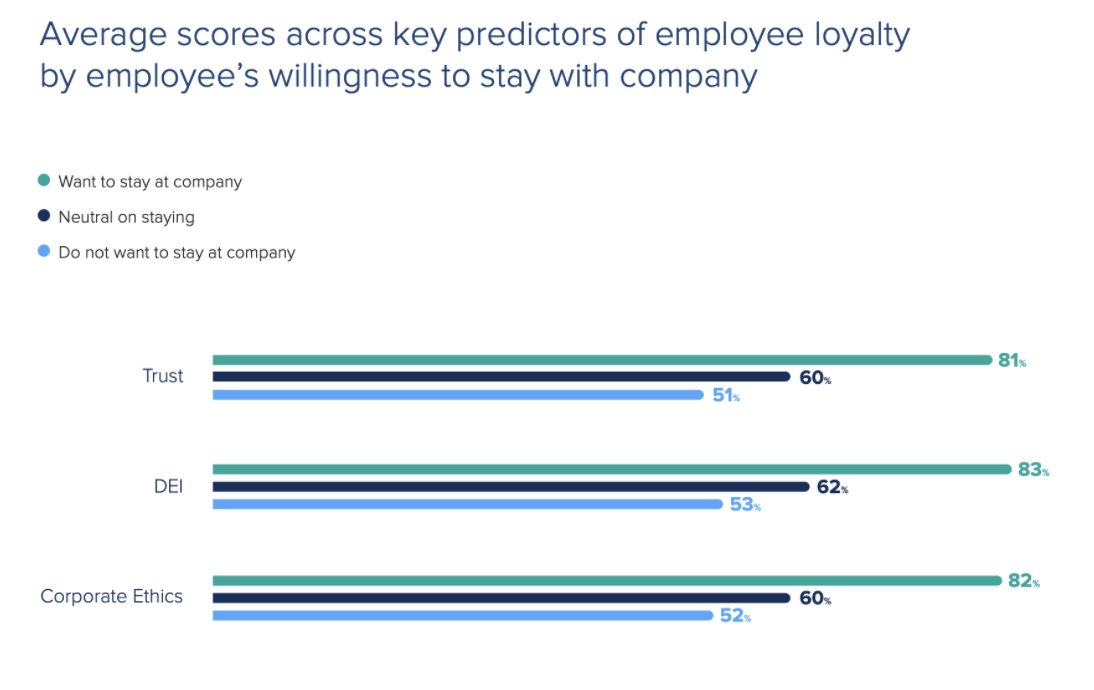
Finally, we see the direct impact that these issues have on employee loyalty. Bottom line: Want to keep your employees? Start with these three things.
Editor’s Picks
- A glossary of modern workplace slang to help you “RTO”
- The first autonomous farm equipment is here
- Why we should embrace the subculture at work
Click here to subscribe to Exit Interview, a weekly email about tech platforms, design, data, and the future of work — straight to your inbox.

